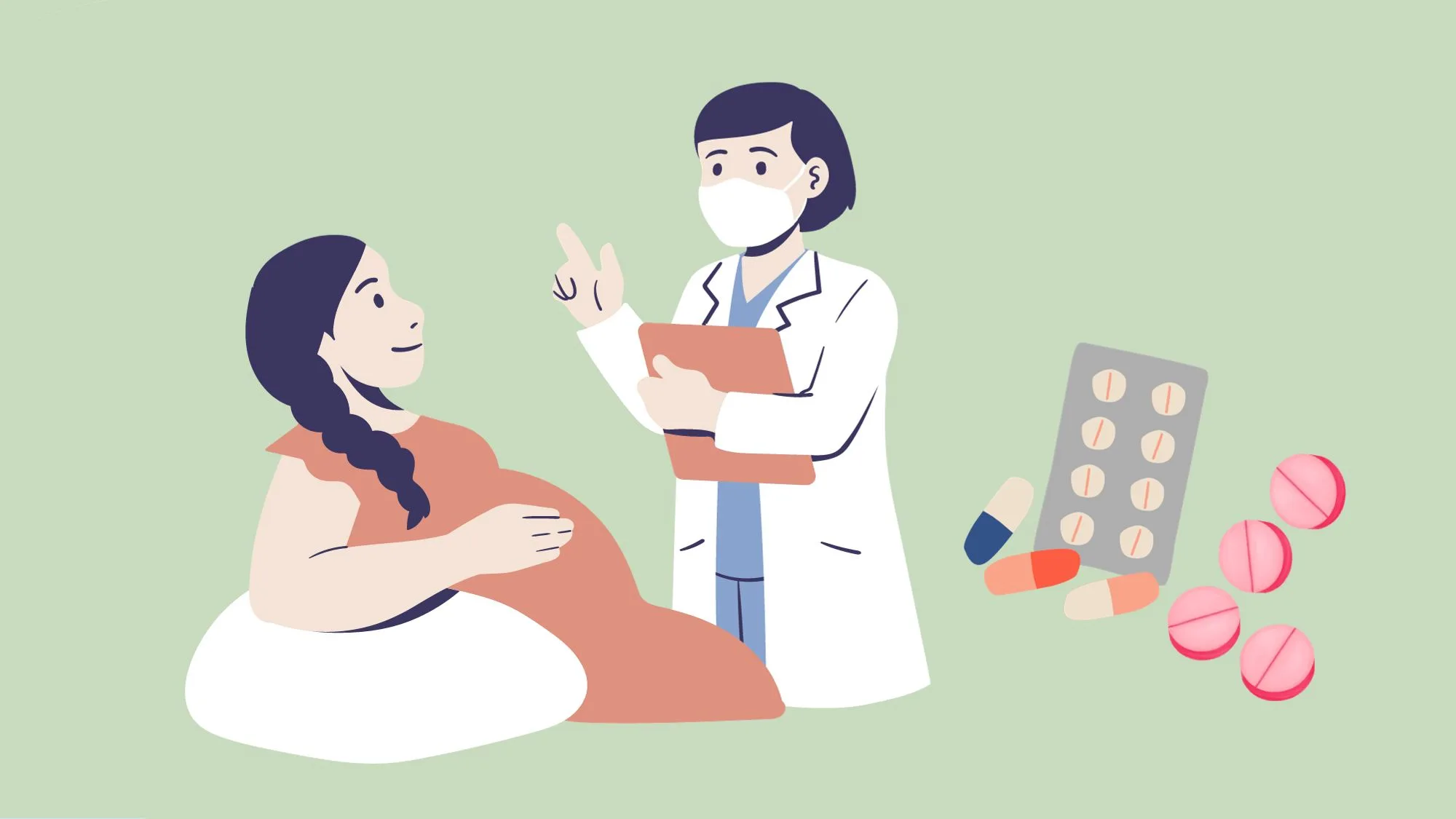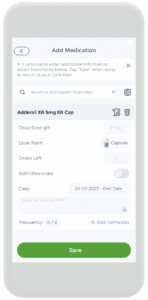
With pregnancy, you might be concerned about continuing to take your prescription medications and the potential risks they may pose for the fetus. One of those medications is Adderall (dextroamphetamine and amphetamine), which may be prescribed by a physician for patients who have trouble focusing and performing activities, such as those with Attention Deficit Hyperactivity Disorder (ADHD). Research shows that the risks of taking prescribed Adderall while pregnant are fairly low, but it is generally recommended to avoid Adderall with a developing fetus. More research needs to be done to develop better guidelines and recommendations in clinical practice. Continue reading the current literature on Adderall for pregnant women!
What is Adderall
Adderall is a drug that is classified as a stimulant made from amphetamine and dextroamphetamine, and it primarily works to help manage ADHD symptoms, such as trouble focusing, impulse control, and staying still. It is also prescribed to help some patients with narcolepsy stay awake during the day. Adderall increases levels of certain neurotransmitters in the brain, specifically dopamine and norepinephrine, which increases physical energy, improves mental aptitude and listening skills, elevates mood, and improvesthe ability to organize tasks.1
Regardless of pregnancy, Adderall, as with any drug, comes with various risks.2 In fact, those who have been taking Adderall long-term have complained of restlessness, headaches, insomnia, dizziness, visual changes, constipation, dry mouth, nausea, vomiting, depression, irritability, loss of appetite, and weight loss.1 These side effects may be amplified or worsened during pregnancy. Pregnancy brings additional mental health considerations that compound medication-related concerns. The hormonal and physical changes during pregnancy can significantly impact mood, anxiety levels, and overall psychological well-being, making comprehensive mental pregnancy analysis essential for expectant mothers managing ADHD medications. Understanding these interconnected factors helps healthcare providers develop more effective treatment plans that address both medication effects and pregnancy-related mental health changes. If any of these side effects persist or worsen, a doctor should be consulted. Adderall may also raise blood pressure, so blood pressure should be monitored regularly.2
Drug reactions
More severe but less common adverse drug reactions include excessive body temperature, heart attack, and stroke. Signs of more serious side effects include: cold, numb, painful fingers or toes that suggest a lack of blood flow, signs of behavioral changes, such as aggression, agitation, depression, or abnormal thoughts, and uncontrolled movements such as continuous chewing, teeth grinding, outbursts of sounds, changes in desires and sexual ability, and prolonged erections in males. Other general signs to be aware of include shortness of breath, chest, jaw, or arm pain, fainting, severe headaches, irregular heartbeats, seizures, ankle or feet swelling, extreme fatigue, blurred vision, muscle weaknesses of any kind, and confusion. Your physician should be consulted in these cases.2
In addition to dopamine and norepinephrine, Adderall may also increase levels of serotonin which increases the risk of a rare but serious condition called serotonin syndrome (also known as serotonin toxicity). Symptoms of serotonin syndrome include severe dizziness, fast heartbeat, hallucinations, loss of coordination, severe nausea, vomiting, or diarrhea, fever, and unusual agitation or restlessness. There are other drugs that work to increase serotonin, and a doctor or pharmacist should be consulted to potential drug interactions.2
Serious reactions
Though extremely rare with Adderall, signs of a serious allergic reaction include rashes, itching, central swelling, severe dizziness, and shortness of breath/ trouble breathing.2
Please note that this is not an exhaustive list of side effects, and a physician should be consulted with any health / medical concerns.
Addiction to Adderall
Adderall comes with risks of addiction as well. Adderall is a prescription stimulant that can be addictive and has similar effects to methamphetamine. The drug is highly potent and readily available, making it easy for people to develop an addiction or abuse it. There is a common misconception that Adderall is a safe drug because it is prescribed by doctors. However, prolonged abuse of stimulant medications can result in lasting side effects and addiction that is challenging to overcome. While not everyone who takes prescribed Adderall will become addicted, those who use it regularly in unapproved doses are at a greater risk of developing an addiction. With prolonged use, individuals can develop a tolerance to Adderall and may struggle to function without it.3
People misuse Adderall because it provides feelings of confidence, euphoria, enhanced concentration, and decreased appetite, making it a popular choice for individuals seeking physical or mental performance enhancements. Using Adderall without a prescription or not as prescribed by a doctor is classified as drug abuse, which includes consuming large doses or snorting pills to achieve a stronger effect.3
Vulnerable populations
Adderall drug abuse is prevalent among people who aim to achieve various goals such as weight loss, academic performance, athletic performance, and staying awake. Although it is commonly associated with high school and college students, older individuals also misuse the drug. The Diagnostic and Statistical Manual of Mental Disorders reported that most individuals who have received treatment for Adderall addiction started using the drug around the age of 23.3
Adderall works by increasing the levels of dopamine and norepinephrine in the central nervous system. Norepinephrine affects how the brain responds to stimuli and can improve attention and reaction time. Dopamine, a natural chemical in the body that produces a sense of pleasure, can create a rewarding effect when unnaturally elevated by drugs like Adderall. This can result in a cycle of seeking more of the drug.3
Dependence vs Addiction
Developing a physical dependence on Adderall is a natural and expected physiological response to the drug, even if taken as prescribed. However, it does not necessarily indicate a psychological dependence where the individual abuses the medication to achieve a “high.” Depending on the impact of the drug on the brain, individuals may require medical assistance to stop taking the medication, but they do not experience mental obsession or crave Adderall.
On the other hand, an Adderall addiction involves an individual’s physical and/or psychological reliance on the drug, accompanied by specific behaviors. These individuals struggle to cope without Adderall and prioritize its use over everything else. They often consume more than prescribed and run out of the medication early, leading to withdrawal symptoms and desperate attempts to obtain more. Obsessive thoughts about Adderall and cravings are also typical in people with addictive behavior.3
Attention Deficit Hyperactivity Disorder (ADHD)
As mentioned earlier, Adderall is a prescription medication that is most commonly prescribed for ADHD, which is one of the most common neurodevelopmental disorders in children.4 However, it can continue and often lasts into adulthood. which can be categorized into two types of behavioral problems:
- Inattentiveness
- Hyperactivity and impulsiveness
Signs of inattentiveness:4
- Easily distracted with short attention span
- Unable to complete tasks that are tedious or time-consuming
- Unable to list or carry out instructional tasks
- Constantly changing tasks or activities
- Difficulty organizing tasks
Signs of hyperactivity and impulsiveness: 4
- Unable to sit still or remain calm/quiet
- Fidgeting
- Inability to concentrate while performing tasks
- Excessive motor movements
- Talkative
- Unable to wait their turn
- Disrupting or interrupting conversations
- Lacking a sense of danger
People with ADHD can have problems in one or both categories. For instance, people may have problems with concentrating and focusing, but no problems with hyperactivity or impulsiveness, a condition known as Attention Deficit Disorder (ADD), which more often goes unnoticed due to more subtle signs and symptoms. For similar reasons, boys are more commonly diagnosed with ADHD when compared to girls, as girls are more likely to have symptoms of only inattentiveness and are thus less likely to display more obvious signs of disruptive behavior that may suggests ADHD.
When symptoms of ADHD go unnoticed or undiagnosed, children do not get the management strategies or treatment they need, which can cause significant problems in their lives, such as poor social interactions, problems with discipline, and academic underachievement. This is an important consideration to make for pregnant patients who greatly benefit from Adderall, where the benefits must be weighed with the risks.4
Types of ADHD Presentations 4
- Predominantly Inattentive Presentation. Individuals may find it hard to organize tasks or complete tasks, with difficulty following instructions or conversations. They may be more easily distracted or pay less attention to details.
- Predominantly Hyperactive-Impulsive Presentation. Patients with this presentation tend to be fidgety and more talkative, with difficulty sitting still for long periods of time. Individuals may feel restlessness and impulsivity, and interrupt others in conversation or speak at inappropriate times.
- Combined Presentation. Individuals will have symptoms of both inattention and hyperactivity/impulsivity.
There is no perfect or single test to diagnose ADHD, and symptoms of other problems, such as anxiety, depression, and learning disability, can present with symptoms that may mimic ADHD. Therefore, in addition to a thorough medical exam, hearing and vision tests, as well as other investigations, should be done to rule out other problems that may present with similar symptoms to ADHD. Diagnosing ADHD using collateral history from parents and teachers can help with the diagnosis as well.
The causes of ADHD are unknown, but research suggests that genetics plays a role. Other current potential causes of ADHD include brain injury, alcohol and tobacco use during pregnancy, premature birth, and decreased birth weight. However, the current evidence is not strong enough to make conclusions.
Treating ADHD
In most cases, the first line of treating adhd is behaviour therapy, before prescribing stimulant medications like Adderall. Some ADHD medications include Adderall (amphetamine), Ritalin (methylphenidate), and Strattera (atomoxetine).5
Birth defects
The current research on taking Adderall while pregnant for expectant mothers suggests that it increases risk of congenital birth defects. Thus, not safe to take during pregnancy. One study examined risk factors associated with major structural birth defects, including the use of ADHD medications, such as Adderall.6 It found that early pregnancy Adderall use was more commonly reported by mothers of infants with gastroschisis, omphalocele, and transverse limb deficiency. Gastroschisis is when the intestines of the baby form outside of the body, which can only be fixed with surgery.7 Similarly, omphalocele is when the organs of the baby form within a sac outside of the body.8 Transverse limb deficiency is another defect when the baby’s arms and legs fail to fully develop.9
More specifically, this study from the Centers for Disease Control and Prevention (CDC) looked at pregnant women taking ADHD medications. And found that there is an increasing number of women taking Adderall while pregnant and that these women are more likely to have a baby with a birth defect.6 It is important to note that there was a small number of children with birth defects overall, and more research is needed on ADHD medications and ADHD symptoms for pregnant women 6
It has been suspected that the use of Adderall while pregnant for longer than approximately five weeks into pregnancy increases the risk of birth defects, as the umbilical cord starts to form and functions as a passage of the drug to the baby.
Low birth weight
There is research that has investigated the possible association of Adderall while pregnant with slightly lower birth weights, defined by babies born with a weight of less than five pounds eight ounces. One study found that dextroamphetamine, which is a component of Adderall, may be associated with low birth weight.10 There were also indications that these babies have additional increased risk of breathing problems, jaundice, and an underdeveloped immune system 11
In general, it can be difficult to do research on the effect of medications on babies in utero. As it would require exposing pregnant women to potentially harmful drugs. Therefore, most studies on Adderall and pregnancy looked at animals. Which found that taking Adderall while pregnant may increase the risk of congenital abnormalities involving the limbs or gastrointestinal tract. In addition to birth defects, pregnant women taking Adderall were more likely to have premature deliveries, babies with low birth weight, and experience withdrawal symptoms, including agitation, dysphoria, laziness, poor feeding, and growth.11
More studies
One article published in 2019 reviewed 8 studies on pregnant women taking Adderall and found no association between Adderall and adverse outcomes in moms or babies. It did find that ADHD medication increased the risks of neonatal intensive care unit admission compared to pregnant women who were not taking these medications. This speaks to the lack of research in this area.12
Some research suggests that Adderall may reduce fertility. For instance, one analysis on 17 animal studies found that ADHD medications impaired reproduction, but there is a lack of research on human subjects. It is also worth noting that these studies were of poor quality with poor reporting. Nonetheless, one of these studies found that 10 rats treated with Adderall failed to produce offspring while all 4 controls (who did not take Adderall) were able to reproduce.13
Alternative options
When conventional drug treatments for ADHD are considered risky in pregnancy. Alternatives might include a referral to a counselor or psychologist for talk therapy in managing symptoms and having a healthy pregnancy. Some women have explored relaxation techniques such as massage therapy, yoga, mindfulness, and meditation. In fact, there was a small study published in 2017 that found an improvement in emotional regulation for women with ADHD who utilized these techniques.14
The CareClinic App has features that allow you to keep track of many and most relaxation techniques, including mindfulness meditation!
Relaxation techniques
You might also experiment with various relaxation techniques like yoga, massage, or meditation. One small 2017 study showed that people with ADHD who practiced mindfulness meditation saw improvement in emotional regulation. Mindfulness meditations has been reported to help people bring their mind to the present moment, which helps to relieve anxiety and improve focus. This can help with regulating emotions, improve executive functioning, and help in managing ADHD symptoms.15
Exercise
Exercise, in general, has been shown to improve reaction times and minimize errors on tests for people with ADHD. One study from 2018 showed people with ADHD had better reaction times and made fewer errors on tests when they engaged in physical activity. Your physician should be consulted when considering safe exercises during pregnancy.16 Studies that investigated a potential link between exercising and ADHD found that it positively targets the same areas of the brain affected by ADHD.17
The CareClinic App can be used to easily track your physical activity!

Other medications
When considering other pharmaceuticals, antidepressants, which stimulate norepinephrine in the brain, may be prescribed by your physician. In other cases, your doctor might deem the benefits of staying on Adderall to be greater than going off it. These decisions are patient-dependent and should be individualized through consultation with your physician 14
Neurofeedback
Neurofeedback, also known as neurotherapy, is a series of sessions that involve attaching electrodes to the patient. In order to receive real-time feedback on the function of their brain. This may help patients improve their neurological functions by learning how to change their way of thinking, which has been shown to help treat ADHD.18
Resuming Adderall
The concern of transferring Adderall substances from expectant mothers to the baby is relevant when the umbilical cord is still intact. Once the cord is cut, it is generally safe to resume taking Adderall. A healthcare provider will have to review drugs given during labour and delivery, and postpartum, or any potential drug side effects and interactions. This is especially important for breastfeeding mothers as dexamphetamine, a component of Adderall, can be transferred through breastmilk.19
The CareClinic App is a great tool that can be used to keep track of all your medications.
Conclusion on the research
Using Adderall while pregnant is considered unsafe, as per the latest research. It can increase the likelihood of birth defects and low birth weight in the baby. However, more studies are necessary to understand the complete effects of Adderall during pregnancy. It is crucial to avoid using Adderall while pregnant, except in rare circumstances when the benefits may outweigh the risks, as determined by a healthcare provider. If you have any doubts or concerns about taking Adderall while pregnant, it’s best to speak with a healthcare provider.
Classifying the safety of drugs
Adderall is a Category C medication. Which means that it should be avoided for a healthy pregnancy and only used before getting pregnant, as the benefits to the mom outweigh the risks to the baby. Category C is part of a previous Federal Drug Administration classification system that categorizes drugs that have been shown to demonstrate adverse effects in animal studies, with no adequate or well-controlled human studies done as of yet. Human studies are higher than animal studies in the hierarchy of evidence. As mentioned earlier, there have been animal studies on Adderall that show a risk of harm to babies in utero. But no human studies have been done. It is therefore categorized as Category C.20
What is the hierarchy of evidence?
The hierarchy of evidence can be described as a ranking system for various scientific studies, typically shown as a pyramid. The further up the pyramid a study is, the more robust its findings are considered to be. The credibility of each study and its position on the pyramid is determined by the level of thoroughness in its methodology.20
The difference between experimental and observational studies
Health research is typically classified into two main categories: observational studies and experimental studies. Observational studies involve observing a group of individuals in their natural setting without any intervention from the researchers, and are sometimes referred to as descriptive studies. These types of studies are limited to identifying correlations and cannot establish causality, such as the link between smoking and cancer.20
Experimental studies, on the other hand, involve introducing an intervention, like a medication, to a group of individuals and observing its effects. These studies have a treatment group receiving the intervention and a control group receiving a placebo. And are often randomized to account for confounding variables 20
The most reliable form of experimental study is the randomized controlled trial (RCT), which can establish causality, unlike observational studies.20
Animal studies
Animal studies have contributed greatly to scientific breakthroughs. One exceptional type of mouse that has been particularly beneficial in microbiome research is the Germ-free mouse. These mice are born via C-section and are raised in a completely sterile environment. This enables researchers to introduce whichever microbes they choose, including single species if necessary. This has significantly enhanced our knowledge of the microbiome and its intricate relationship with host organisms 20
Mice offer a valuable alternative for research when human studies are not feasible due to ethical considerations. For example, studies on mice have uncovered the potential for the microbiome to induce significant behavioural and weight changes in mammalian hosts. When bacteria from humans with Manic Depressive Disorder are transplanted into germ-free mice, they display increased despair behaviours and stress, indicating a link between the microbiome and mental health.20
Although animal and in vitro studies are ranked lower than human studies in the hierarchy of evidence, they provide essential insights and inspire new avenues of research. Germ-free mice, in particular, have been instrumental in advancing our understanding of the microbiome.20
References
- “Drugs & Medications.”Webmd.com, 2019, www.webmd.com/drugs/2/drug-63163/adderall-oral/details.
- Lautieri, Amanda. “What Are the Long-Term Effects of Heavy Adderall Use?”American Addiction Centers, 2015, americanaddictioncenters.org/adderall/long-term-effects.
- Juergens, Jeffrey. “Adderall Addiction and Abuse – Prescription Amphetamines.” AddictionCenter, 2013,addictioncenter.com/stimulants/adderall/.
- “Symptoms – Attention Deficit Hyperactivity Disorder (ADHD).”NHS, NHS, 2018, www.nhs.uk/conditions/attention-deficit-hyperactivity-disorder-adhd/symptoms/.
- —. “Use of ADHD Medicine Is Increasing among Pregnant Women | CDC.” Centers for Disease Control and Prevention, 16 July 2020, www.cdc.gov/pregnancy/meds/treatingfortwo/features/keyfinding-ADHD-med-increase.html.
- Anderson, Kayla N., et al. “ADHD Medication Use during Pregnancy and Risk for Selected Birth Defects: National Birth Defects Prevention Study, 1998-2011.”Journal of Attention Disorders, vol. 24, no. 3, 9 Mar. 2018, pp. 479–489, https://doi.org/10.1177/1087054718759753.
- “Facts about Gastroschisis.”Centers for Disease Control and Prevention, 27 June 2017, www.cdc.gov/ncbddd/birthdefects/gastroschisis.html.
- “Facts about Omphalocele.”Centers for Disease Control and Prevention, 17 Nov. 2015, www.cdc.gov/ncbddd/birthdefects/omphalocele.html.
- “Facts about Upper and Lower Limb Reduction Defects.”Centers for Disease Control and Prevention, 20 Apr. 2018, www.cdc.gov/ncbddd/birthdefects/ul-limbreductiondefects.html.
- Humphreys C, Garcia-Bournissen F, Ito S, Koren G. Exposure to attention deficit hyperactivity disorder medications during pregnancy. Can Fam Physician. 2007 Jul;53(7):1153-5. PMID: 17872810; PMCID: PMC1949295.
References
- “Adderall Addiction And Abuse”. https://www.addictioncenter.com/stimulants/adderall/
- “Symptoms of ADHD | Attention-Deficit / Hyperactivity Disorder (ADHD) | CDC”. https://www.cdc.gov/adhd/signs-symptoms/index.html/
- “The Kids Most Likely to Have ADHD In the U.S.”. https://time.com/3857689/adhd-hyperactivity/
- “ADHD Medication Use During Pregnancy and Risk for Selected Birth Defects: National Birth Defects Prevention Study, 1998–2011 – PMC”. https://pmc.ncbi.nlm.nih.gov/articles/PMC6119527/
- “Prenatal amphetamine exposure and birth outcomes: a systematic review and metaanalysis – PubMed”. https://pubmed.ncbi.nlm.nih.gov/21658669/
- “The Effects of Drugs used for the Treatment of Attention Deficit Hyperactivity Disorder (ADHD) on Pregnancy Outcome and Breast-feeding: A Critical Review – PMC”. https://pmc.ncbi.nlm.nih.gov/articles/PMC9185785/
- “Associations of prescribed ADHD medication in pregnancy with pregnancy-related and offspring outcomes: A systematic review – PMC”. https://pmc.ncbi.nlm.nih.gov/articles/PMC7338246/
- “The Differential Impact of Acute Exercise and Mindfulness Meditation on Executive Functioning and Psycho-Emotional Well-Being in Children and Youth With ADHD – PubMed”. https://pubmed.ncbi.nlm.nih.gov/34194365/
- “Acute Physical Activity Enhances Executive Functions in Children with ADHD – PMC”. https://pmc.ncbi.nlm.nih.gov/articles/PMC6098027/
- “Dextroamphetamine – Drugs and Lactation Database (LactMed®) – NCBI Bookshelf”. https://www.ncbi.nlm.nih.gov/books/NBK501740/
- “Exposure to attention deficit hyperactivity disorder medications during pregnancy – PMC”. https://pmc.ncbi.nlm.nih.gov/articles/PMC1949295/
- “Pregnancy category”. https://en.wikipedia.org/wiki/Pregnancy_category
- “Hierarchy of evidence | EBSCO Research Starters”. https://www.ebsco.com/research-starters/health-and-medicine/hierarchy-evidence
- “Hierarchy of evidence: a framework for ranking evidence evaluating healthcare interventions – Evans – 2003 – Journal of Clinical Nursing – Wiley Online Library”. https://onlinelibrary.wiley.com/doi/full/10.1046/j.1365-2702.2003.00662.x


